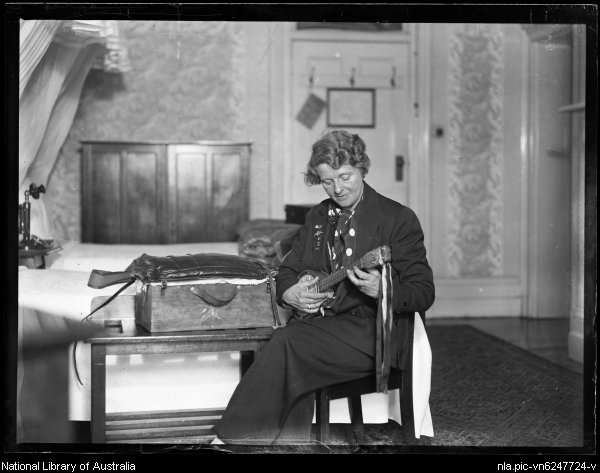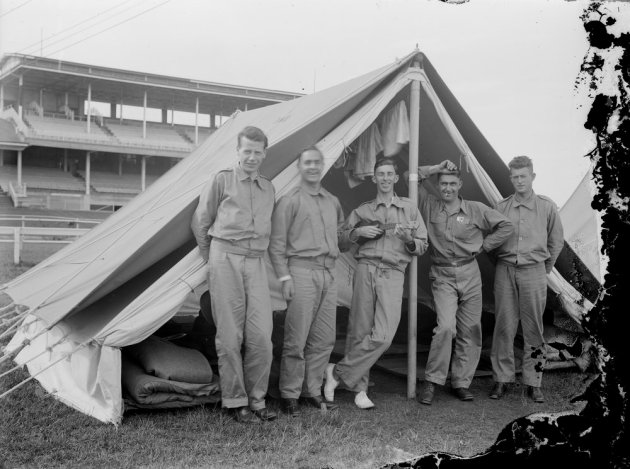Found this beautiful student animation on Youtube. It’s about an old Hawaiian souvenir and his ‘Ukulele Lady’. Great use of the song. There are some talented people out there
Kat
Bayside Ukes member.

Found this beautiful student animation on Youtube. It’s about an old Hawaiian souvenir and his ‘Ukulele Lady’. Great use of the song. There are some talented people out there
Kat
Bayside Ukes member.

Australian Soldiers WW2
On Anzac Day, the 25th of April, we remember Australians at war.
Although the ukulele was introduced to Australia before 1915, there is little evidence that it was played during World War One by Australian troops at Gallipoli or on the Western Front in Europe. It was not until after 1918 that the huge popularity of the ukulele in America ensured it spread to the rest of the world Ref. 1 . By World War Two Australian soldiers adopted the ukulele as part of their unofficial kit, as they tried to bring some cheer to their lives at camp and at the front.
In America during the 1920s and 1930s, Buster Keaton (and his ukulele), was an established star of silent movies and Cliff “Ukulele Ike” Edwards was famous as a singer and ukulele player in Vaudeville. Both starred in the film “Doughboys” (1930), that loosely depicts Keaton’s wartime experiences during his service in France during WWI Ref 2. One great scene shows Buster and Cliff playing the same ukulele while Cliff sings and Buster scats.
In Australia the ukulele gained popularity during the interwar period. It was appreciated as an entertainment by soldiers in a hospital for war veterans. The Argus (Melbourne, Vic, 25 May 1932, p.6) newspaper reported that Lady Chaytor entertained the patients with her ukulele at the Caulfield Military Hospital. Lady Chaytor was from County Durham, England and had flown to Australia as a passenger in a two seater Gypsy Moth to commence a series of lectures on fashion. Her only luggage was one small suitcase and her ukulele. She visited Caulfield Hospital saying “she felt that she was of the A.I.F., for her brother, who at an early age ran away from home, had enlisted from Queensland”. She visited each of the wards, sat on the piano and sang many songs playing her ukulele and accompanied by the singing of the men.

Lady Chaytor with her ukulele in Sydney, Australia, 1932
During World War II George Formby is well-documented entertaining British and allied troops at the front with his banjo ukulele. It is much harder to find photographs and videos of Australian troops being entertained by Australian ukulele performers. Unlike Britain and America, Australia had only a small contingent of entertainers for the diggers during World War Two. The ukulele appears to have been a more private instrument that men could take with them to the battlefield.

Sheet music for the ukulele became prolific and patriotic during World War Two.
The ukulele and music were very important to many American soldiers during their time in Australia. Jack Earle an American gunner, was recovering in Perth from shell-shock. For him music was “half his life”and he appealed for an instrument in the newspaper after losing two while on active duty. It was quickly replaced the next day by an anonymous female donor (Daily News, Perth W.A. Tues. 16 Sept. 1941, pg. 16) which was only possible due to the popularity of the ukulele in Australia.

U. S. Marines with ukulele, Ballarat, circa. 1943, Charles Edward Boyles (National Library of Australia).

World War 2 Australian Soldier
P.O.W. Whittling Starts WA Ukulele Industry.
Boredom-killing whittling in Changi prisoner of war camp has started up an in-dustry in Western Australia that might become a dollar-earner. Partner in JMG Industries at Jolimont Les O’Connell, filled in his spare time at Changi using a knife on coconut shells and pieces of tea chests to make a ukulele. Heartened by his success he made a carved top ukulele which musicians in the camp hailed as a topline instrument. O’Connell decided to go into the business on his liberation. This story was told today by his partner Jack Maskiell who was with O’Connell in Changi. He said that it took six months to produce the first local ukulele. From then on the ukuleles were marketed throughout Australia with great success. ‘We got a bit cheeky,’ said Maskiell. ‘We sent them to Singapore and Ceylon and now dollar-earning samples are in the U.S.. ‘We also have them in Britain.’ The firm has now produced 3000 ukuleles and 700 guitars…… Maskiell lost a leg in Changi. (The Daily News, Perth, 16 May 1950, pg. 9)

Rats of Tobruk ukulele 1943
After the siege of the Garrison at the Libyan port of Tobruk in 1941 Ref. 3, this ukulele (pictured above) was adopted as a permanent record of the West Australian Battalion known as The Rats of Tobruk. It was owned by a Corporal Smith and played before and during the siege, but became a memento of the event. Pictures of rats were scratched at the headstock with the word Tobruk, then 200 signatures were scratched on the front and back of the ukulele by the men of the unit. It was returned to Western Australia after Corporal Smith was taken prisoner (Daily News, Perth, W.A. Wed, 21 April 1943, pg. 7).
More ukulele stories, photographs and artwork of Australian soldiers can be found in the Australian War Memorial.
The Australian War Memorial – “A Sentimental Song”
Soldiers 1941 – Australian War Memorial
Soldier in Hospital with ukulele – Australian War Memorial
Zilla
Bayside Ukes member.
8. If you are bopping to the music you won’t whack the person next to you in the face because the Uke has a short neck
9. You can do a speech as a Uke song. It makes this less painful for both you and the audience
10. If you play the Uke you belong to a worldwide community of fellow ukers and you need never play alone
So make the most of your Uke. It is such a versatile instrument
Kat
Bayside Ukes member

For ukulele aficionados out there, I have discovered a very old uke music book. I was going through my late mother’s music collection and found this:
” The E easy Z
METHOD FOR UKULELE AND UKULELE-BANJO
A very easy and practical system
containing just the necessary material for
SELF-INSTRUCTION.”
Mum was a classical and Jazz pianist in the 1930s and played professionally. I am not sure why she had a uke book. It was probably for someone in the band. It cost four shillings and sixpence or eleven pence posted. This edition was published in Australia by J. Albert & Son Pty Ltd, Sydney, circa. 1935. While the manual has the original copyright for W. J. Smith Music Co. Inc., New York for 1924, it also has two illustrations with the copyright for 1934 and 1935. It must have been an effective teaching method because it is still in print and new editions of this book can be found online.
Interestingly, the tuning of the strings was different: ADF#B. Apparently this was popular in the 1920s and 1930s and considered to make the uke sound brighter and more compatible with guitar chords if you were playing in a band. This would be like playing from the third fret of the soprano ukulele tuned to GCEA.
The book contains a mixture of traditional and old popular songs, including Play It On Your Little Uke.
The EZ method was also considered suitable for other instruments such as the Tiple, Uke-I-Tar, Guitar-Uke, Taropatch. In the book it says that the Guitar-Uke and Uke-I-Tar are other names for the Tenor Guitar that is played like a ukulele. The Taropatch has 4 pairs of strings, each pair tuned to the same note. The Tiple (Tee-plee) is a ten stringed instrument played in pairs or triplets.

A story aside… On the same day I discovered the uke book, I was looking at an old book of Mendelssohn Concertos that my Mum played and three fifty-dollar notes fell out. Paper notes in fact and probably from the 1980s. Imagine? A voice from the grave I reckoned.
Now I am a pretty average uke player, so my tips are not really for the experts, but I play ‘easy’ as they say. My sorry old fingers don’t always reach with appropriate pressure to give a good sound. So I cheat a little. I frequently only play the bottom 2 or 3 strings of a chord, making sure to only strum those strings accordingly. It works very well for say an F Minor or B Flat, or B and many others. This depends on your own fingering capabilities really. Really handy for quick changes and not really noticed in group playing!
Another tip I’m working on is Substitute Chords. Playing at home some of the chords I read are seemingly impossible, or infrequently used and easily forgotten. You can play around and get ‘close’. Once again I’m cheating. For instance G Minor instead of B Flat 7, or C9 instead of EM7 Flat 5. I’m sure many folk know many more. But have a play and see how you go!
Cheers, Helen.
Bayside Ukes member.
Taimane Gardner demonstrates her ukulele skills and some moves at the Kamaka stand, NAMM 2016 in Anaheim, 5th February 2016. For those lucky enough to be going up north, she will be performing at the Cairns Ukulele Festival in August.
Bayside Ukes